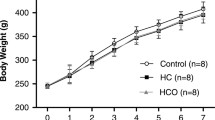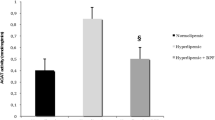Abstract
Endothelial cells may play a potential role in cholesterol efflux from peripheral tissues to liver. Cholesterol efflux from cells is essential for activation of the reverse cholesterol transport pathway and cardiovascular health. One of the cholesterol transporters is steroidogenic acute regulatory protein (StAR) which promotes intramitochondrial delivery of cholesterol to the cholesterol side-chain cleavage system. The aim of the present study was to determine the effects of a niacin–chromium complex on aortas of hyperlipidemic rats and on the cholesterol efflux from aorta endothelial cells by examination under light and transmission electron microscopes and evaluating the StAR immunoreactivity, respectively. Aorta lipid peroxidation (LPO) and glutathione (GSH) levels were determined by spectrophotometric methods. After treating hyperlipidemic animals with the complex, the StAR immunoreactivity in endothelial cells increased to achieve cholesterol homeostasis and efflux. Combined treatment with niacin and chromium resulted in an inhibition in the mast cell secretion and a decrease in lipid vacuole size in unilocular adipose tissue surrounding aorta, as well as in a decrease in morphological degenerations observing in aorta of hyperlipidemic rats. Aorta LPO levels increased and GSH levels decreased in the hyperlipidemic group, whereas treatment with niacin and chromium reversed these effects. In conclusion, this study reveals that combined treatment with niacin and chromium prevents the morphological and biochemical changes observed in thoracic aorta of hyperlipidemic rats, and may regulate effectively cardiovascular diseases inducing an increase in StAR levels on endothelial cells.








Similar content being viewed by others
References
Major AS, Dove DE, Ishiguro H, Su YR, Brown AM, Liu L, Carter KJ, Linton MF, Fazio S (2001) Increased cholesterol efflux in apolipoprotein AI (ApoAI)-producing macrophages as a mechanism for reduced atherosclerosis in apo AI (−/−) mice. Atheroscler Thromb Vasc Biol 21:1790–1795
Reiss AB, Martin KO, Javitt NB, Martin DW, Grossi EA, Galloway AC (1994) Sterol 27-hydroxylase: high levels of activity in vascular endothelium. J Lipid Res 35:1026–1030
Javitt NB (1994) Bile acid synthesis from cholesterol: regulatory and auxilary pathways. FASEB J 8:1308–1311
Bjorkhem I (2002) Do oxysterols control cholesterol homeostasis? J Clin Invest 110:725–730
Babiker A, Andersson O, Lund E, **u RJ, Deeb S, Reshef A, Leitersdof E, Diczfalusy U, Bjorkhem I (1997) Elimination of cholesterol and macrophages and endothelial cells by the sterol 27-hydroxylase mechanism: comparison with high density lipoprotein-mediated reverse cholesterol transport. J Biol Chem 272:26253–26261
Janowski BA, Willy PJ, Devi TR, Talck JR, Mangelsdorf DJ (1996) An oxysterol signalling pathway mediated by the nuclear receptor LXR alpha. Nature (London) 383:728–731
Costet P, Luo Y, Wang N, Tall AR (2000) Sterol-dependent transactivation of the human ABC1 promoter by LXR/RXR. J Biol Chem 275:28240–28245
Venkateswaren A, Laffitte BA, Joseph SB, Mak PA, Wilpitz DC, Edwards PA, Tontonoz P (2000) Control of cellular cholesterol efflux by the nuclear oxysterol receptor LXRalfa. Proc Natl Acad Sci USA 97:12097–12102
Maxfield FR, Wustner D (2002) Intracellular cholesterol transport. J Clin Invest 110:891–898
Jefcoate C (2002) High-flux mitochondrial cholesterol trafficking, a specialized function of the adrenal cortex. J Clin Invest 110:881–890
Hall EA, Ren S, Hylemon PB, Agudo DR, Redford K, Marques D, Kang D, Gil G, Pandak WM (2005) Detection of the steroidogenic acute regulatory protein, StAR, in human liver cells. Biochim Biophys Acta 1733:111–119
Ning Y, Chen S, Li X, Ma Y, Zhao F, Yin L (2006) Cholesterol, LDL, and 25-hydroxycholesterol regulate expression of the steroidogenic acute regulatory protein in microvascular endothelial cell line (bEnd.3). Biochem Biophys Res Commun 342:1249–1256
Pandak WM, Ren S, Marques D, Hall E, Redford K, Mallonee D, Bohdan P, Heuman D, Gil G (2002) Hylemon P. Transport of cholesterol into mitochondria is rate-limiting for bile acid synthesis via the alternative pathway in primary rat hepatocytes. J Biol Chem 277:48158–48164
Ren S, Hylemon PB, Marques D, Hall E, Redford K, Gil G, Pandak WM (2004) Effect of increasing the expression of cholesterol transporters (StAR, MLN64, and SCP-2) on bile acid synthesis. J Lipid Res 45:2123–2131
Ledwozyw L, Michalak J, Stepien A, Kadziolka A (1986) The relationship between plasma triglycerides, cholesterol, total lipids and lipid peroxidation products during human atherosclerosis. Clin Chim Acta 155:275–284
Beutler E (1975) Glutathione in red blood cell metabolism: a manual of biochemical methods, 2nd edn. Grunne and Stratton, New York
Linsel-Nitschke P, Tall AR (2005) HDL as a target in the treatment of atherosclerotic cardiovascular disease. Nat Rev Drug Discov 4:193–205
Genest JJ, McNamara JR, Salem DN, Schaefer EJ (1991) Prevalence of risk factors in men with premature coronary artery disease. Am J Cardiol 67:1185–1189
Kashyap ML (1989) Basic considerations in the reversal of atherosclerosis: significance of high density lipoproteins in stimulating reverse cholesterol transport. Am J Cardiol 63:56–59
DiPalma JR, Thayer WS (1991) Use of niacin as a drug. Annu Rev Nutr 11:169–187
Bolkent S, Yanardag R, Bolkent S, Doger MM (2004) Beneficial effects of combined treatment with niacin and chromium on the liver of hyperlipidemic rats. Biol Trace Elem Res 101:219–230
Inceli MS, Bolkent S, Doger MM, Yanardag R (2007) The effects of combined treatment with niacin and chromium on the renal tissues of hyperlipidemic rats. Mol Cell Biochem 294:37–44
Urberg M, Benyi J, John R (1988) Hypocholesterolemic effects of nicotinic acid and chromium supplementation. J Fam Pract 27:603–606
Bagchi D, Stohs SJ, Down BW, Bagchi M, Preuss HG (2002) Cytotoxicity and oxidative mechanisms of different forms of chromium. Toxicology 180:5–22
Preuss HG, Anderson RA (1998) Chromium updates: examining recent literature 1997–1998. Curr Opin Clin Nutr Metab Case 1:509–512
Wang MM, Fox EA, Stoecker BJ, Menendez CE, Chan SB (1989) Serum cholesterol of adults suplemented with Brewer’s yeast or chromium chloride. Nutr Res 9:989–998
Schroeder HA, Vinton WH, Balassa JJ (1962) Effect of chromium, cadmium and lead on serum cholesterol of rats. Proc Soc Exp Biol Med 109:859–860
Altschul R, Hoffer A, Steohen JD (1955) Influence of nicotinic acid on serum cholesterol in man. Arch Biochem Biophys 54:558–559
Grundy SM, Mok HY, Zech L, Berman M (1981) Influence of nicotinic acid on metabolism of cholesterol and triglycerides in man. J Lipid Res 22:24–36
Kashyap ML (1988) Mechanistic studies of high density lipoproteins. Am J Cardiol 82:42–48
Sakai T, Vai**ath S, Kamanna S, Kashyap ML (2001) Niacin, but not gemfibrozil, selectively increases LP-AI, a cardioprotective subfruction of HDL, in patients with low HDL cholesterol. Atheroscler Thromb Vasc Biol 21:1783–1797
Zambon A, Hokanson J, Brown BG, Brunzel SD (1999) Evidence for a new pathophysiological mechanism for coronary artery disease regression, hepatic lipase-mediated changes in LDL density. Circulation 99:1959–1964
Gardner CD, Chatterjee LM, Carlson JJ (2001) The effect of a garlic preparation on plasma lipid levels in moderately hypercholesterolemic adults. Atherosclerosis 154:213–220
Khanna AK, Rizvi F, Chander R (2002) Lipid lowering activity of Phyllanthus niruri in hyperlipidemic rats. J Ethnopharmacol 82:19–22
Devi R, Sharma DK (2004) Hypolipidemic effect of different extracts of Clerodendron colebrookianum Walp in normal and high-fat diet fed rats. J Ethnopharmacol 90:63–68
Lindstedt KA, Leskinen MJ, Kovanen PT (2004) Proteolysis of the pericellular matrix: a novel element determining cell survival and death in the pathogenesis of plaque erosion and rupture. Atheroscler Thromb Vasc Biol 24:1350–1358
Lee M, Lindstedt KA, Kovanen PT (1992) Mast cells-mediated inhibition of reverse cholesterol transport. Atheroscler Thromb 12:1329–1335
Lee M, Kovanen PT (2006) Mast cell proteases: physiological tools to study functional significance of high density lipoproteins in the initiation of reverse cholesterol transport. Atheroscler 189:8–18
Yanardag R, Peksel A, Yesilyaprak B, Doger MM, Arisan-Atac I (2005) Effects of a combination of niacin and chromium (III)-chloride on the skin and lungs of hyperlipemic rats. Biol Trace Elem Res 103:249–260
A-Atac I, Peksel A, Yanardag R, Sokmen BB, Doger MM, Bilen ZG (2006) The effect of combined treatment with niacin and chromium (III) chloride on the different tissues of hyperlipidemic rats. Drug Chem Toxicol 29:363–377
Author information
Authors and Affiliations
Corresponding author
Rights and permissions
About this article
Cite this article
Suren Castillo, S., Doger, M.M., Bolkent, S. et al. Cholesterol efflux and the effect of combined treatment with niacin and chromium on aorta of hyperlipidemic rat. Mol Cell Biochem 308, 151–159 (2008). https://doi.org/10.1007/s11010-007-9623-2
Received:
Accepted:
Published:
Issue Date:
DOI: https://doi.org/10.1007/s11010-007-9623-2




